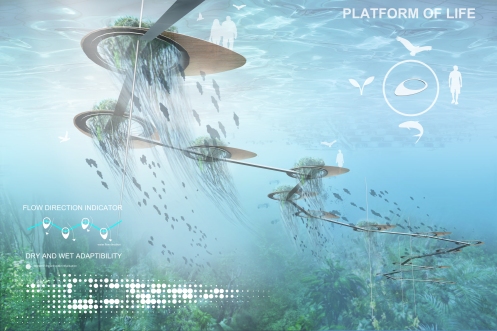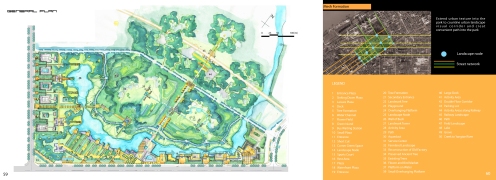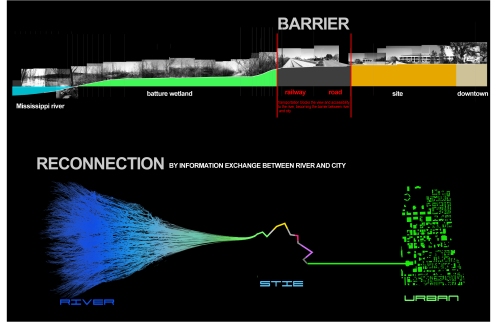I want to explore the ecological system which includes bird, fish, plant, micro-organism and the proof of the changing habitat. I want to define the changing space of habitat system which was shaped by the important parametric– water. And I also need to define the edge between changing and stable areas.
I will photograph the mark of change as proof, but mainly the outcome will be different areas define on the base map, combined with mark of water level.
Although my digital model is so abstract, it still take lots of work of programming. It simply turns everything into math. The exciting thing lies in the process of decode and code, and to make ideas come true step by step (though only in digital form). And I truly realize the importance of having a nice computer.
To work with nature is to work with uncertainty, especially at such dynamic sites as desoto park. Too many forces comes and goes, interacting with each other. Our landscape is shaped by numerous of tiny incidents in different scales. We human as visitors, are too careless and limited to catch all those incidents. The design should add in to and influence that course of countless incidents.
This amazing gif picture is generated by locust, a plug-in of grasshopper, which itself is a plug-in for rhino. The function of locust is to imitate birds or insect Swarm intelligence. It can imitate different types of behaviors such as seek, avoid, wander, cohesion, record the positions of each individual and their path. Isn’t it exciting to design a building reshapes itself to let the bird flow through or a waterscape shaped by fish? Or even more, to imitate the swarm behavior of human being to design architecture and landscape?
But the possible danger of grasshopper or any digital design technique also lies here–to equal human with emotionless dots. Many digital designs I’ve seen lack human scale. They are driven by the idea that house is living machine, or any other kinds of functional machine. The harder we try to imitate human being in digital ways, maybe the further we are from the real people. It comes to question that whether each of us is utterly unique being.
Then what is the form, or shape of architecture in future? I think the answer is no shape, or every shape. The core of intelligence is to respond and react with changes. So different situation and function will generate different shape of architecture. Or there is even no pure ‘architecture’, since there will be a trend of synthesizing of building, electronic appliance, landscape and transportation system. Technology development brings uncertainty.
Bellow is several envisage of city in future, from 2012 Skyscraper Competition
I sat there and found everthing is moving, with their own language and pattern. I realize that I am watching movie consisted by countless shots. There are long take, short take, close shot and still shot. I am unwilling to start systematic analysis. I only want to record every shot I saw, every word I found in the language of the surrounding environment.
Micro and macro scale are hard to define. Bug has its own scale of sense, and we human have our own observation limitations. The depth and range between sitting at one spot observing for 2 hours and walk through the site in 10 minutes is totally different. The rhythm of micro and macro scale are some times the same. For example, the tide at the riverside has the same rhythm of ripples in the pond caused by the charge of water at high tide. Wind shakes trees in large-scale similar to the frequency of the quivering of a thin leaf. Same things are happening, both in large-scale and small-scale. The difference is whether you see a close shot or panorama.
My recording interval is changing through the meditation process. At first, I was hurry to record everything went into my eyes. They are a hotchpotch, lacking of hierarchy and subjective feeling. But when I settled down for a while, I turned into an easy mode, starting to notice every small noise, sound, motion, objects. This part of record is quite rational and systematic. After about an hour, I felt get used to and ‘merged’ into the environment. I am not separated from the environment as an observer, but becoming a part of it. This is the time you can understand the language of trees, bird, water, bugs, and feel like your own language.
Surly the temporal changes are important in the understanding of sites. What you see is only one moment, one shot, one frame, but it will overlap with countless moments you see before, and you can realize the kinetic process, like the animation. And every motion has its own rhythm and pattern. These are the keys of understanding the site.
























